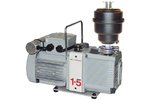- ▶
- Heaters/Source
- ▶
- Agilent Heaters and SensorsMass Spectrometry, Scientific Supplies & ManufacturingScientific Instrument Services 5973 Source Heater Tamper Resistant Allen Wrench 5973/5975 Quad Sensor 5985 Source Heater Assembly Agilent Interface Heater Assembly 5971 Interface Heater

- ▶
- VacuumPumps Oils/Greases Gauge & Tubes Hose & Accessories Filters - Oil/Charcoal Foreline Traps Gaskets & Material Fittings O-Rings Pump Parts (Precision Plus) Quality Monitor System Distillation Control Acoustic Enclosures For Rotary Vane Pumps Other Vacuum Accessories Digital Vacuum pressure regulator (VPC) Catalog Page F1

- ▶
- Other Vacuum AccessoriesGreenwood Containers Rietschle Vacuum Pump Filters Thermo/Finnigan MAT Incos 50B Vacuum Measurement System 5 Gallon Drum Pump Inland Acidity Test For Vacuum Pump Fluids SIS Replacement Charcoal Filter Element SIS Coalescing Filter Replacement Element Adjustable Gas Ballast Oil Return Kit for Edwards Pumps

- LiteratureApplication Notes Adsorbent Resins Guide Mass Spec Tips SDS Sheets FAQ MS Calibration Compound Spectra Manuals MS Links/Labs/ Organizations MS Online Tools Flyers on Products/Services Scientific Supplies Catalog About Us NextAdvance Bullet Blender® Homogenizer Protocols Micro-Mesh® Literature Instrumentation Literature Agilent GC/MS Literature SIS News / E-Mail Newsletter NIST MS Database - Update Notifications

- ▶
- Mass Spec Tips1 - Freon for use in Mass Spectrometer Leak Checking 2 - Mass Spectrometer Probe Cooling 3 - Sample Vials for Direct Probes 4 - Selection of Vacuum Pump Oils for Lowest Mass Spec Background 5 - Determination Linkages in Biomolecules of Disulfide 6 - Transfer of H.P. ChemStation MS and GC Chromatograms from PC to MAC Computer 7 - Repairing Clogged Thermospray Probes 8 - Tuning a Finnigan 5100 to Meet BFB or DFTPP Criteria 9 - H.P. 5971 Transfer Line Tip for Direct Introduction of Capillary Column 10 - Troubleshooting Finnigan 5100 GC/MS Systems 11 - Leak Checking Mass Spectrometers 12 - Elimination of Memory Peaks and GC Background Noise 13 - SuperIncos Mapped Software Print Buffer Lockup 14 - Reduction of Peak Tailing 15 - Electron Multiplier Sensitivity 16 - INCOS Procedure for Calibrating on the Finnigan 4500 17 - Extending Electron Multiplier Life 18 - What techniques or methods do you use to determine if the electron multiplier 19- What techniques or methods do you use to detect vacuum leaks in your mass spectrometer 20 - Extending Lenear Range of the Mass Spec Article - Improving Sensitivity in the HP 5971 Mass Spectrometer - Part 1 and Part 2

- ▶
- 4 - Selection of Vacuum Pump Oils for Lowest Mass Spec Background (This Page)
 Mass Spec Tips is a collection of tips relating to the operation
and service of mass spectrometers. Some of these Tips have been
reported in our newsletter, "The Mass Spec Source."
If you have a question relating to the operation or service of
mass spectrometers or would like to add your comments to the below
tip and would like to have it included in this forum, please contact us.
Input to this database of MS Tips is needed from our readers
to complete this section.
Mass Spec Tips is a collection of tips relating to the operation
and service of mass spectrometers. Some of these Tips have been
reported in our newsletter, "The Mass Spec Source."
If you have a question relating to the operation or service of
mass spectrometers or would like to add your comments to the below
tip and would like to have it included in this forum, please contact us.
Input to this database of MS Tips is needed from our readers
to complete this section.
Author: John J. Manura
Affiliation: Scientific Instrument Services
Significant background peaks are present in the mass chromatogram especially when using the mass spectrometer to detect and identify samples in the sub nanogram levels. These peaks occur due to backstreaming of the hydrocarbons from the oils into the mass spectrometer source. In both the rough pumps and the diffusion pumps, oils are used which can contribute to this spectra background. Backgrounds in the spectra can occur due to byproducts in the oil itself or due to mass spectrometer samples which are collected and trapped in the pump oils as samples are analyzed. The high temperatures and continued 24 hour a day use of the oils can cause them to break down (commonly referred to as cracking). These lighter fractions can cause peaks in the mass spectrometer background. In order to minimize these background peaks the rough pump oils should be changed every three months and the diffusion pump oils every 2 years. When changed the oils should be replaced with the most highly refined highest molecular weight chain hydrocarbon fractions which can be safely utilized in the vacuum pumps.
About 5 years ago we replaced the Inland 19 Oils in our rough pumps with Invoil 21 which was more highly refined and produced better backgrounds. Although this oil was more expensive it produced lower vacuum pumping capacity and minimized mass spectrometer background. In the last two years Inland 45 has been developed which is even more highly refined and will produce the least amount of vacuum pump backstreaming. It can be used in all Alcatel, Edwards and Leybold vacuum rough pumps utilized on mass spectrometers to obtain the lowest mass spectrometer background and optimum vacuum pump performance. We now use it in all of our instruments.
For the diffusion pump Santovac 5 is still the best quality oil available. In the more than 30 years that Santovac 5 has been routinely used in mass spectrometers, no new oil has been developed which surpasses its low vacuum level pumping capacity as well as its low backstreaming. For diffusion pumps which currently use other oils, the user must check that Santovac 5 can be used in these pumps before replacing the oil. The boiling point of the diffusion pump oil must be matched to the heater cartridge wattage in the diffusion pump. We have safely replaced the diffusion pump oils in the H.P. 5971 with Santovac 5 without any change in the diffusion pump heaters. The only improvement to the use of this oil in diffusion pumps would be to replace the diffusion pumps with Turbo pumps. Turbo pumps will provide the lowest background levels.

